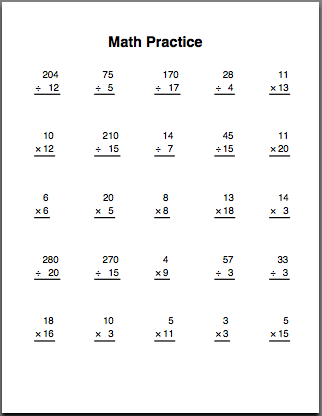Okay, for those of you who didn't grow up in the 80's, the title of this post is in reference to a quote from Ferris Bueller, for whom "choice" means "great."
I get a lot of questions about differentiation strategies. My favorite recipe for differentiated math instruction involves setting up a structure like this:
I have described components of this recipe in previous posts (such as these), so I won't go into all of that now.
For this post, I want to highlight a couple of simple ways that creating opportunities for student choice or self directed instruction can help with differentiation specifically during the "Practice" phase which is shaded in orange in the diagram above.
For this post, I want to highlight a couple of simple ways that creating opportunities for student choice or self directed instruction can help with differentiation specifically during the "Practice" phase which is shaded in orange in the diagram above.
Practice is a crucial part of concept building. The point of "practice" is to guide, question and coach students as they work independently and collaboratively to master concepts, strategies and procedures. This being the case, timely, high-quality feedback is essential.
When we hear the word "practice" linked with math, we might have visions of worksheets like this one dancing in our heads:

These are your garden variety high floor low ceiling worksheets, just right for a narrow range of students. To differentiate, teachers may offer up a smorgasbord of these worksheets stacked on a back table or in an accordion folder. I will admit, I've tried this tactic myself in the past, but the reality was that I could not provide my students with timely, high quality feedback this way. I simply couldn't keep up. Without timely, high quality feedback, we run the risk of having students practice a skill incorrectly or using rote memorization rather than conceptual understanding to muscle through.
SO... What are some other options?
Choice Menus
One way to make practice customized and meaningful is to inject some choice within parameters by developing menus.For example, here is a template that I use to make practice menus: Math Choice Menu Template.You can use whatever language you like, but the idea is that there are certain practice problems that are required (Main Dishes), others that you choose among (Side Dishes) and still others that are completely optional, but still great (Desserts).
With fewer problems that get at the heart of what you want students to be able to know and do, providing feedback and allowing revisions in a heterogeneous classroom becomes MUCH more manageable.
If you want to see an example of how this look in practice, you can check out this choice menu that a colleague and I created for his seventh grade math class last year (Cuisenaire Variable Equations Menu).
Choice Boards
Generally, these are a tic-tac-toe style board of options that students choose among. I've often used these as a way to differentiate practice and to provide a some individualized support for students are various stages of meeting proficiency.This is a choice board template that we created in the middle school. Here are a few examples of boards we've used:
If you're interested in more information about how to create choice boards, here's a great go to resource for that.
Mindset for Making Choices
A little self-directed instruction can increase student engagement, but to really leverage this engagement we need to push our students to think about what choice is most appropriate for their growth at a point in time.I always frame these choices using math mindset language ( for more info see this post and Jo Boaler's youcubed.org site). I emphasize that choices provide a starting point, but that all students are capable of reaching for that dessert table. Some just need a little more practice and feedback to get there. However, the temptation to make inappropriate choices can be strong...
Take this experience for example:
A couple of years ago, I gave my students a choice board and asked them to circle their choices. Next, I had them self assess for some skills related to the learning target. Then, we looked back at the choice board and I revealed to them what skills and concepts each of the choices was designed to target. I asked them to reflect on their choices. Did they make growth choices (that targeted skills they needed to strengthen) or fixed choices (that targeted skills they already had mastered)?
Many students discovered that they were choosing to avoid what they perceived as their weaknesses and needed to revise their choices to target their needs.
Looking for More?
If you're interested in learning more about self-directed instruction, here is a link to the resources that I included with a differentiated instruction training that I lead a couple of years ago. Let me know if you'd like more posts like this one.To make this post a Bueller sandwich, I will note that my husband pokes fun at me for my obsession with Jo Boaler by monotoning, "Boaler... Boaler..." in reference to this guy (who reminds me a lot of those endless worksheets):
Be still my heart.

No comments:
Post a Comment